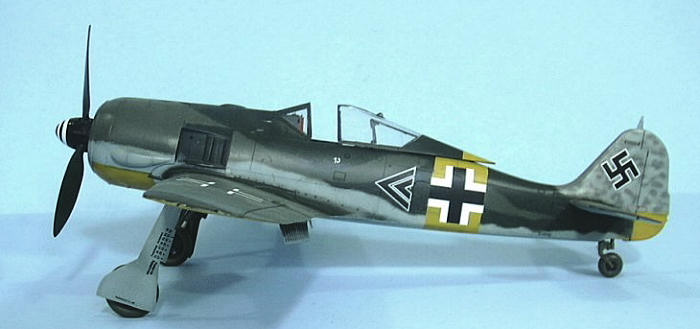
| KIT #: | 08073 |
| PRICE: | $44.95 MSRP |
| DECALS: | Two options |
| REVIEWER: | Tom Cleaver |
| NOTES: | Eagle Cals sheet #82 used. |

| HISTORY |
The Fw-190A series was so right in design that - once the problem of providing
adequate cooling for the BMW 801 radial engine was solved - the airframe went
through little modification other than minor changes associated with changes in
armament.
The one major change between the early subtypes A-1 - A-4 aircraft and the later
series following the A-5 subtype involved
a change in the engine mount for center-of-gravity
problems associated with use of various armament fittings.
This lengthened the forward fuselage 5.9 inches, just
ahead of the wing leading edge.
The Fw-190A-5, which maintained the armament of the A-3 and A-4 sub-types of two
MG17 7.62mm machine guns in the forward fuselage, two MG151 20mm cannon in the
wing root and two MG-FF 20mm cannon in the outer wing position, replaced the A-4
in production in April 1943.
The Fw-190A-5 was phased out of production in June 1943
in favor of the Fw-190A-6 which differed in having a modified wing with a
lighter structure and the outboard MG-FF cannon replaced by the far superior
MG151.
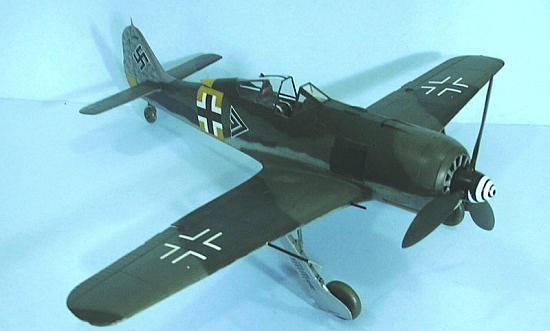 Both the A-5 and A-6 subtypes remained in service on the Eastern Front well
after the introduction of the heavier and more heavily-armed A-8 subtype,
because their light weight and superior maneuverability was needed in the low
altitude fighter-versus-fighter air combat found on the Eastern Front, where the
heavy armament of the A-8 - so necessary in opposing the American heavy bombers
- was not needed.
The last of these sub-types did not leave service with
JG 54 until the end of 1944, and that was primarily due to their being worn out
in operations.
Both the A-5 and A-6 subtypes remained in service on the Eastern Front well
after the introduction of the heavier and more heavily-armed A-8 subtype,
because their light weight and superior maneuverability was needed in the low
altitude fighter-versus-fighter air combat found on the Eastern Front, where the
heavy armament of the A-8 - so necessary in opposing the American heavy bombers
- was not needed.
The last of these sub-types did not leave service with
JG 54 until the end of 1944, and that was primarily due to their being worn out
in operations.
Walter Nowotny:
Walter Nowotny
Born December 7, 1920 at Ceske Velenice/Gmünd on the
Czechoslovakian/Austrian border, Known as “Nowi,” Nowotny joined the Luftwaffe
on October 1, 1939, undergoing
flying training at Jagfliegerschule
5 at Schwechat, near Vienna, after which he was promoted to
Leutnant and posted to JG 54 on
February 23, 1941. Leutnant Nowotny was assigned to
9./JG 54.
Nowotny first saw combat following the invasion of the Soviet Union, when he
claimed his first victories,
two Russian I-153 biplane fighters shot down over Ösel
Island on July 19, 1941, being immediately shot down in turn by an I-153, flown
by the future Russian ace Alexandr Avdeev over Riga Bay.
He spent
three days and nights at sea in a rubber dinghy before
finally reaching shore, to discover he was about to be listed as killed in
action.
By
September 13, he scored his tenth victory.
Always a good shot, he found his “shooting eye” in the
summer of 1942, when he shot down five Russian fighters on
July 20th,
following that on August 2 with a claim of seven enemy aircraft shot down for
his
48th through 54th victories. On August 11, he shot down two MiG-3s,
though his Bf-109G-2
was hit and caught fire. He managed to bring the burning
fighter
back to his base for a crash-landing.
Nowotny was awarded the Ritterkreuz
September 4, 1942, for 56 victories, and was
appointed Staffelkapitän
of 1./JG 54 on October 25th,
where he began to fly the Focke-Wulf Fw-190A.
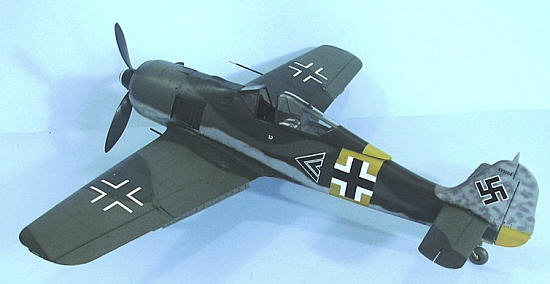 On March 26, 1943, Nowotny got into a fight with the first Russian-flown
Spitfires, operated by the 26 GvIAP
,and shot down one for his 79th victory. Over the month of June 1943, he shot
down 41 aircraft, including five on June 1, six on June 8,
his 100th victory on June 15th
, six on June 21,
and 10 on June 24.
On March 26, 1943, Nowotny got into a fight with the first Russian-flown
Spitfires, operated by the 26 GvIAP
,and shot down one for his 79th victory. Over the month of June 1943, he shot
down 41 aircraft, including five on June 1, six on June 8,
his 100th victory on June 15th
, six on June 21,
and 10 on June 24.
Nowotny was appointed Gruppenkommandeur
of I./JG 54 on August 10th,
and shot down
49 enemy aircraft that month, including nine on August 13th
, six on August 18th,
and seven on August 21st. His scoring continued in
September when he shot down 45 enemy aircraft, including
ten on September 1st; five in a matter of 12 minutes on
a morning sortie and the other five in nine minutes at noon, following this with
six victories the
next day. He was awarded the
Eichenlaub and promoted to Hauptmann
on September 4th for 189 victories.
He shot down number 200 among five on September 8th,
then scored six each on September 14th
and 15th, bringing his total to
215.
The Schwertern was awarded on
September 22nd for 218 victories.
During his last ten days of combat on the Eastern Front, Nowotny shot down 32 Russian aircraft, including eight on October 9th , six on October 13th and a final six October 14th, to give him 250 victories. With this, Nowotny was the first fighter pilot in history to pass 250 victories. In recognition of his status as the top-scoring fighter ace of the Luftwaffe, he was the eighth recipient of the Brillanten on October 16th. He was then withdrawn from combat, being sent to various Luftwaffe bases for morale-boosting until he was given command of JG 101, an operational fighter training unit, on April 1, 1944. That July he was placed in command of what became known as Kommando Nowotny, the first Luftwaffe unit to take the Me-262 jet fighter into combat. He was shot down and killed in his Me-262 by fighters of the 8th Air Force on November 8, 1944.
| THE KIT |
This is the third kit in Hasegawa’s line of 1/32 Fw-190s, being their first
release of an early-version A-model.
I think they went
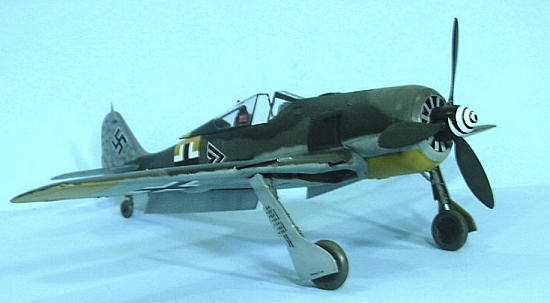 with
the A-5 due to the fact that the different parts - lower wing, gear doors,
fuselage gun cover -are minimal from the A-8.
with
the A-5 due to the fact that the different parts - lower wing, gear doors,
fuselage gun cover -are minimal from the A-8.
Those modelers who have gotten the Fw-190A-8 will see that the only changes are
the parts listed above.
Unfortunately, Hasegawa did not do the early wheel with
the lighter hub, and they also have created an early seat that is mostly a
modification of the later seat from the Dora-9, which is quite different from
that used on the A-models.
While not entirely accurate as an early seat, it is
useable and I did so with this kit.
Eagle Editions does make a more accurate seat for those
who need it.
The kit provides decals for two aircraft - one Fw-190A-5 flown by Major Hermann Graf before it was modified with the supercharger intakes on the cowling sides, and another A-5 of JG 2. Fortunately, several of the aftermarket decal makers have started producing sheets for the early Fw-190A-5/A-6, and I used Eagle-Cals Fw-190A-5 sheet EC 82, which includes Nowotny’s final Fw-190A-5.
| CONSTRUCTION |
Construction
differs only slightly from the Fw-190A-8 kit, and so I will only comment on
those.
I
used the kit seat, with Eduard photo-etch seatbelts.
The unfortunate thing about the Fw-190 is that - when
the model is complete - one can only really see the seat, so that all the nice
detail one gets from a resin cockpit is hard enough to see that it might as well
not be there, though the seat belts really improve the kit seat to the po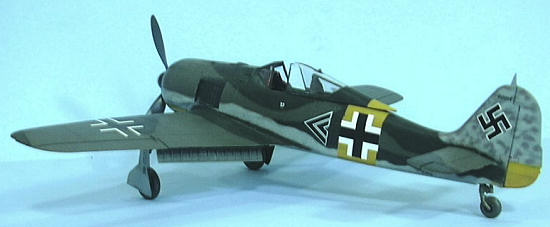 int
one doesn’t need even the resin replacement here.
int
one doesn’t need even the resin replacement here.
As to the rest of the kit, the only difference in assembly is the wheel well
doors, which include the inner doors that completely enclosed the wheel well on
the early A-models.
Just as I was about to use these inner doors, I checked
with the Eagle Cals sheet and realized that Nowotny didn’t have the inner doors
on the final airplane, as it was equipped with the later, larger wheels, since
they were operating in such muddy conditions.
This was good news since I didn’t have to get the resin
early wheels, which are really needed on this kit
Most of the Fw-190s on the Eastern Front did not use the drop tank, so I left
that mounting off in the assembly.
Past that, I will refer you to the other full-build reviews of the Fw-190A-8
here at Modeling Madness for a more detailed discussion of the assembly process,
since it is the same for this kit.
| COLORS & MARKINGS |
Painting
The most distinctive early-model Fw-190As to see operational use with the
Luftwaffe were those operated by JG 54 during
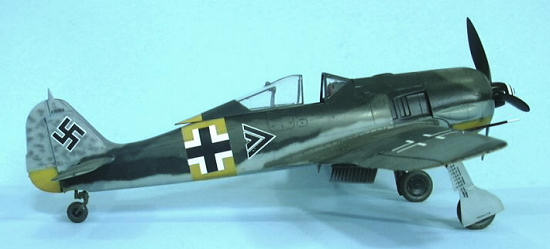 1943.
The unit was in a static location on the northern front,
and all the aircraft were repainted in the field from the standard 74/75/76
camouflage, with the upper surfaces painted in either RLM70/71 or a combination
of the two standard Greens with RLM79 Sandy Brown.
No two of these aircraft looked exactly the same, and it
is important to have a photograph available if you are trying to determine
whether a particular airplane was in the two greens or the green/brown scheme.
1943.
The unit was in a static location on the northern front,
and all the aircraft were repainted in the field from the standard 74/75/76
camouflage, with the upper surfaces painted in either RLM70/71 or a combination
of the two standard Greens with RLM79 Sandy Brown.
No two of these aircraft looked exactly the same, and it
is important to have a photograph available if you are trying to determine
whether a particular airplane was in the two greens or the green/brown scheme.
Decals:
Since the airplane was painted in the field, it’s likely that all the
overpainted stenciling was not replaced, so all I did was apply the very nice
Eagle Cals markings, which went on without trouble.
The model was then given an overall coat of Xtracrylix
Flat Varnish.
| FINAL CONSTRUCTION |
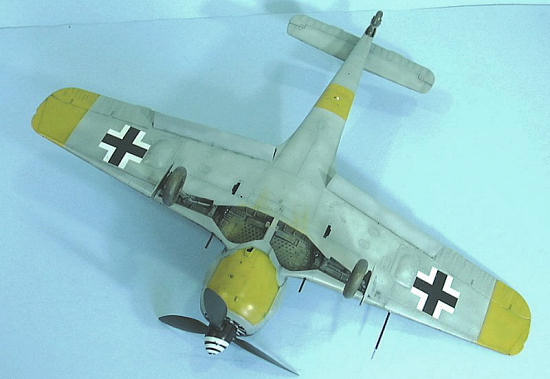 Since this airplane was only used for the final month Nowotny was in combat, I
didn’t give it a lot of “dings,” but did give it exhaust staining.
I attached the landing gear, flaps, and the canopy in
the open position after unmasking the windscreen and canopy.
Since this airplane was only used for the final month Nowotny was in combat, I
didn’t give it a lot of “dings,” but did give it exhaust staining.
I attached the landing gear, flaps, and the canopy in
the open position after unmasking the windscreen and canopy.
| CONCLUSIONS |
I
swore when I started this that it would be the last big Hasegawa Fw-190, then
saw at the local hobby shop that among the kits now being sold off of the
collection that never got built from the local obsessive-compulsive kit
collector who died this fall was the limited-run Fw-190A-6 with checkerboard
cowl.
So, as Hemingway once said of cats - “one cat leads to another” - so one
more Fw-190 is likely to be built.
That said, I have long wanted to do Nowotny’s airplane
because it looks so different from all the others, and this finished model looks
very good sitting next to all the other Wurgers
Review kit compliments of my wallet.
December 2008
If you would like your product reviewed fairly and quickly, please contact me or see other details in the Note to Contributors.